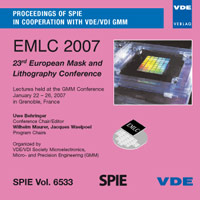Revisiting Mask Contact Hole Measurements
Conference: EMLC 2007 - 23rd European Mask and Lithography Conference
01/22/2007 - 01/26/2007 at Grenoble, France
Proceedings: EMLC 2007
Pages: 8Language: englishTyp: PDF
Personal VDE Members are entitled to a 10% discount on this title
Authors:
Higuchia, Masaru (Toppan Electronics Inc., M.S. 9651A, Essex Junction, VT 05452)
Gallagher, Emily; Bowley, Reg; McGuire, Anne (IBM Microelectronics, M.S. 9651A, Essex Junction, VT 05452)
Ceperley, Daniel (Electrical Engineering and Computational Sciences, University of California, Berkeley, CA 94720)
Brunner, Timothy (IBM Microelectronics, M.S. 40E, Hopewell Junction, NY 12533)
Abstract:
Contact holes represent one of the biggest critical dimension (CD) mask metrology challenges for 45nm technology mask development. The challenge is a consequence of both wafer and mask sensitivities. Large mask error factors and the small process windows found when contact holes are imaged on wafers impose very tight mask specifications for CD uniformity. The resultant CD error budget leaves little room for mask metrology. Current advanced mask metrology deploys a CD-SEM to characterize the mask contact hole CD uniformity. Measuring a contact hole is complex since it is inherently two-dimensional and is not always well-characterized by one-dimensional x- and y-axis measurements. This paper will investigate contact metrics such as line edge roughness (LER), region of interest (ROI) size, area, and CD sampling methods. The relative merits of each will be explored. Ultimately, an understanding of the connection between what is physically measured on the mask and what impacts wafer imaging must be understood. Simulations will be presented to explore the printability of a contact hole’s physical attributes. The results will be summarized into a discussion of optimal contact hole metrology for 45nm technology node masks.


